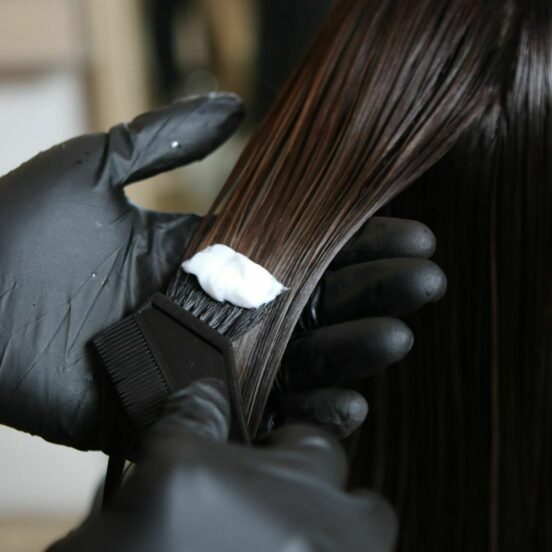
What Is The Best Hair Bleach For Black Hair? - Top Brands Of Hair Bleach For Dark Hair
If you are looking for the best bleach for dark hair at Sally's or Walmart the options seem endless. And endlessly confusing! Unlike lighter haired people who can just bring their hair to blonde with a hi-lift no bleach hair color, dark haired beauties need a bit more work to become blondes. The following list of high quality products are our best hair bleach for black hair choices to help you get started in your journey to lighter hair.
What to Look for In a Hair Bleach For Dark Hair
As the bleach removes pigment from your hair, it also removes protein and weakens the bonds that make your hair strong and healthy. The more pigment that there is to lift, the higher the potential for damage. So if you want to go from dark hair to blonde you need to be very careful about which type of bleach you choose.
The best hair bleach for black hair usually is one with additives that help protect and condition your hair during the lifting process. At the same time, you want a fast acting bleach that minimised the time your hair is being processed. If you want to lift several levels in one sitting, such as going from dark brunette to dark blonde or lighter, you want to splurge in a high quality bleach and the right developer. Cheapening will only lead to more hair damage and the need for expensive restorative treatments... or a radical hair cut.
What Level of Bleach Should I Use for Dark Hair?
When you ask what level of bleach should you use what you actually are looking at is at what volume developer to use with bleach. Developer is the activator for the lightening powder used to make the bleach mixture active.
Most people will mix bleach with a 30 vol. developer, as that offers the best balance between lifting powder and hair damage. 40 vol. bleach is just too strong and has too much risk, whereas 20 vol. developer will most likely be too weak to seriously lighten black hair.
However, if you opt for going lighter in several sessions, you may be able to use 20 vol. developer on your last and final bleaching step. This will help your hair condition but will only work if the first bleach session got you close to your desired hair color.
Always follow the instructions of the bleach you choose in order to ensure the best performance and less damage to your hair, particularly if you are bleaching dark hair at home and are not an expert colorist.
If you have never bleached your hair, doing a strand test on a hidden strip of your hair is highly recommended. This is even more important if you have a history of hair dyes and hair treatments, straightening, heat damage or very fragile hair. After bleaching your hair shouldn't break and shouldn't feel gummy, if it starts feeling gummy or straw like you may have damaged hair integrity permanently.
Things To Consider Before Bleaching Dark Hair
Going from black or dark brown hair to blonde is a process that can be harmful to hair, and it's not something you should approach lightly. It's also quite difficult to go back from blonde to your natural color so if you are known to change your mind maybe you should experiment with a wig first.
That said, it's lots of fun and I personally think everybody should try at least once to go blonde! Just keep in mind the following before you get started:
- Are you happy to have high-maintenance hair? You may need to re-do your roots regularly, deep treatments, more frequent trimmings
- If your hair was too damaged and you had to cut it off significantly, how would you feel about that?
- How comfortable are you being your own hairdresser? Bleach application can be more tricky than hair dye, even with all the YouTube tutorials in the world
- Are you happy to spend more money on your hair to keep it as healthy as possible?
- Are you likely to change your mind and miss your dark hair?
- Radical hair changes often need clothing colors and makeup changes to avoid you looking washed out. What looked great on you as a brunette may look jarring as a light blonde. Or maybe you will love the extra drama!
Going blonde is a serious commitment in terms of self-image and maintenance, so if you aren't 100% sure you'd love how you look as a platinum blonde you may want to go slowly, lightening more and more in stages. You could start with some highlights, and then add more as you feel more comfortable with your image as a blonde.
How To Bleach Dark Hair at Home
Bleaching your hair at home deserves its own article and watching many instructional videos, but before you go shopping for the best bleach for dark hair remember the following.
Should I Use Bleach Additives?
I would say, categorically, yes. If you care about the health of your hair, want to go blonde quick or have fragile hair, using bleach additives can make the bleaching process much less damaging on your hair.
Bleach additives such as Olaplex Bond Builder, L'Oreal Smartbond and similar products work by protecting or rebuilding the disulfide bonds in your hair that bleach destroys. This keeps the hair in much better condition and allows you to lift hair safely many more levels. Remember the celebrities going from dark brown hair to platinum blonde in one (very long) sitting? That used significant amounts of bleach additives, often only available from salons and for hair and beauty professionals.
Some bleach products also incorporate their own bleach additives to protect and nurture your hair during the lifting process, and they may or not be compatible with bond builders. It's worth checking the brand, as the likelihood of products being compatible increases if they are from the same brand.
Even if it makes the bleaching process slightly slower or more time-consuming, the fact that your hair is less likely to fry is a good reason to use bleach additives when bleaching hair at home. It's a bit of cost upfront to save you lots of restorative treatments and potentially permanent damage in the future.
However, keep in mind that no bond builder or moisture protector will fully stop your hair from being damaged by bleach. When you bleach your hair, the hair cuticles are raised and proteins are destroyed, and it just can't go back to being the same as natural, virgin hair was.
What Volume Developer Should I use?
If you are doing your roots, or a full process all-one-color bleach, you will be more comfortable with 20 vol. bleach. Even if it involves doing it over two sittings, and pampering your hair in between. Bleach can cause chemical burns in your scalp if you use high-volume peroxide.
30vol. can be uncomfortable on the scalp, and can damage hair more. If you have healthy hair and are used to having your hair bleached, you should be ok with this volume developer.
40vol. developer should only be used on off-scalp processes, such as balayage, ombre, or highlights, when you need to accomplish a lot of lift in one session. This will cause the most damage to your hair but at the same time is the most effective.
However, when bleaching your hair, effective doesn't always mean best, and given that bleach can actually chemically burn your hair or scalp, being careful and slow is the best idea.
You can read this guide to hair developer levels to learn more about which developer is best for your hair.
Hair Bleaching Aftercare Tips
Once you have used the best bleach for dark hair, you are left with the aftermath. Bright blonde hair that requires even more love than your natural tresses. Even if you have natural hair and are used to a high maintenance wash and style regime, bleached hair often requires even more, though its requirements will sound familiar.
Your hair will be lacking in protein and have issues keeping moisture. This is great if you had oily hair and were used to having to wash often, as many people will bleached hair can significantly drop the amount of weekly washes. In fact, your second and third day hair will probably look even better and have more volume you are used to.
On the other side, you will need to pamper it and nurture it back to being healthy and strong. Protein treatments and bond builders such as the Olaplex at-home range are priceless here. Many people love doing oil treatments on their newly bleached hair to increase moisture retention, but be careful as some oils can lead to yellowing hair.
Yellow hair, the curse of bleach blondes everywhere. Even just a few days after toning you may be wondering "How do I get yellow out of my hair!" and brassy tones suit nobody. So stock up on purple shampoos and toning masks and enjoy your brighter, blonde hair for longer.


